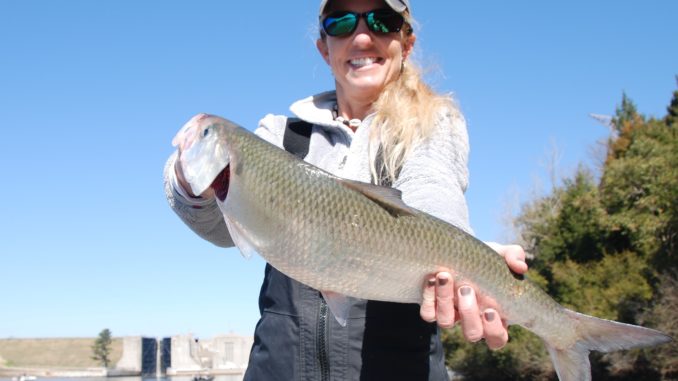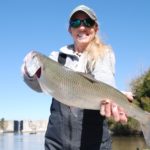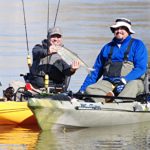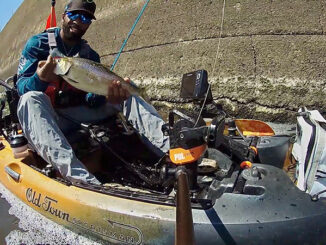
Coastal rivers ready to fill up with feisty fish
Rivers along the coast of the Carolinas have always been great places to paddle. They offer scenic beauty, miles of water devoid of boat traffic more common to impoundments and areas around inlets, and most are home to some phenomenal kayak fishing.
The big news on coastal rivers this time of year is the annual migration of American and Hickory shad, which will leave the open ocean and travel miles inland up rivers in response to spawn.
In North Carolina, the Roanoke, Tar, Neuse and Cape Fear rivers and their tributaries are the most-popular destinations for spawning shad. North Carolina sees more Hickory shad than American shad due to the heavy commercial fishing of American shad offshore, they have gained substantial ground from restocking efforts by the N.C. Wildlife Resources Commission.
In South Carolina, American shad are the more predominant species, with the Savannah, Cooper, Santee and Black rivers, and the ACE Basin, being primary entry points. Shad have been known to move as far inland as Columbia, S.C., after locking through the dam at Pinopolis and working their way up the Congaree and Wateree Rivers.
Lewis Brownlee, a kayak angler from South Carolina’s Lowcountry, said shad migrations key on two factors: water flow and water temperatures. Brownlee said he’s caught American shad in the Cooper River as early as Christmas and as late as Mother’s Day, but the primary dates are late February and March when water temperatures reach 50 degrees.
“A lot of anglers refer to it as the first fish of the spring … so shad fishing is a great way to get a good start, as 50 to 75 fish a day is very possible,” he said.
Another benefit of the kayak for shad fishing is accessibility to water that might otherwise require bank-fishing.
“You can slide a kayak in just about anywhere you have public access and paddle out to nearby structure like a bridge piling or rock pile,” he said. “Safety is the important thing, because the shad are drawn to the current. They also prefer deeper water, and the water (is) still pretty cold. You don’t want to take a spill this time of year.”
Popular locations include the tailraces behind any impoundment on a coastal river or any structure, natural or man-made, that increases water flow along that route. Shad will hug the bottom in swifter current and tend to concentrate behind structure, pausing for a few minutes in an eddy or depression before resuming their mad migration.
Brownlee suggests that paddling anglers come equipped with a good grappling anchor to position the boat into the current.
“An anchor trolley is a must to get the anchor point to the front or rear of the kayak,” he said. “Most of these water-flow areas are not places to be broadside to the current, especially if dams upstream are releasing water.”
The combination of depth and current requires some weight to your bait presentation. Historically popular baits for shad are heavy spoons or shad darts paired with a smaller, crappie-sized curlytail. The spoon or dart is used to get the baits down in the water column, and the curlytail jig follows the heavier bait on a 1- to 11/2-foot tag line.
“I prefer to tandem-rig two 1/8-ounce jigs,” Brownlee said. “I use two Z-man Shroomz jigheads. American shad can get pretty big. My best is a 22-inch fish that pulled me off my anchor site in the kayak and actually provided a little sleigh ride. A fish like that can straighten out a regular crappie hook, so I like to use stouter jigheads.”
Brownlee pairs the jigheads with 2-inch Z-Man Grubz bodies. Chartreuse with a little flake accent is his hands-down favorite, but white, yellow and gold are popular colors.
Tackle typical of shad fishing is light- to medium-action spinning gear paired with 8-pound line. North Carolina anglers can expect to catch Hickories that average a pound, with 3 pounds being something to brag about. American shad, which are 100-to-1 in catch rates over the hickory shad in South Carolina, tend to be larger, averaging 2½ pounds, with specimens of 6 to 7 pounds lurking about.
The appeal of shad fishing is definitely more for sport than table fare, despite some of the signage you might see this time of year in front of a backroads café. Shad fight hard and are known to go airborne when hooked. The fish have hard mouths, which often explains why you’re hooked up one minute and reeling in slack line the next.
Shad are exceedingly oily, typical of anadromous fish that move inland to spawn. Locals are known to favor the fish for its roe, which in the South is often served fried with grits. The fish itself makes for excellent catfish bait, exuding an odor that has been compared to a truck-stop restroom.
But for table fare or sport, the fishing is here, so grab your paddle and head to the nearest coastal river.







Be the first to comment